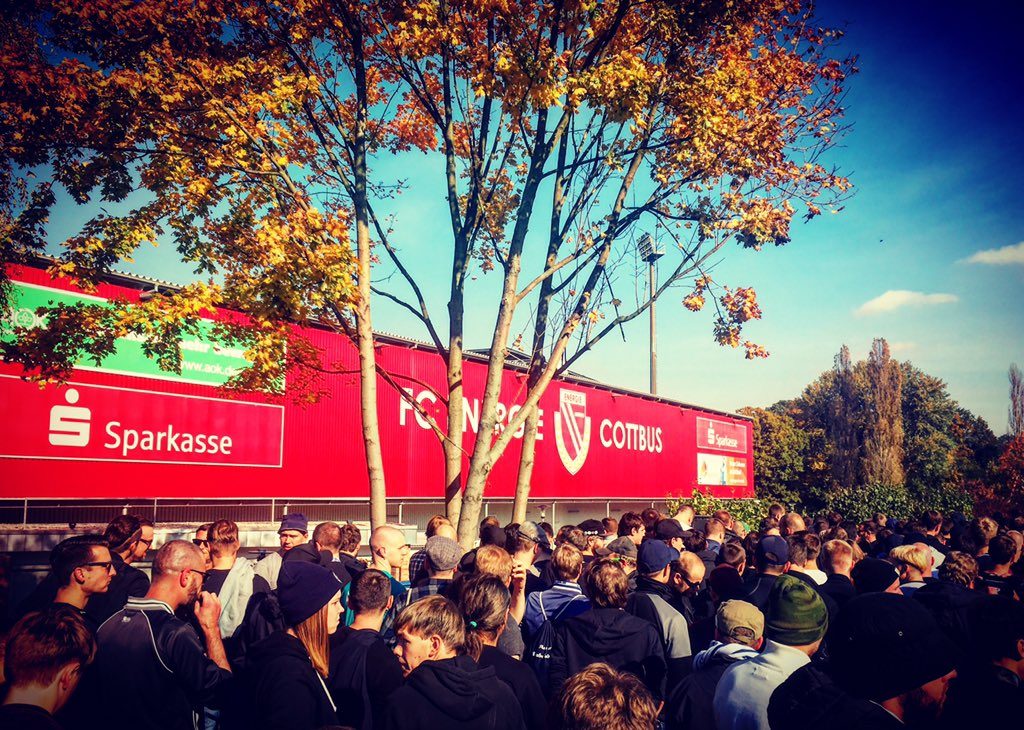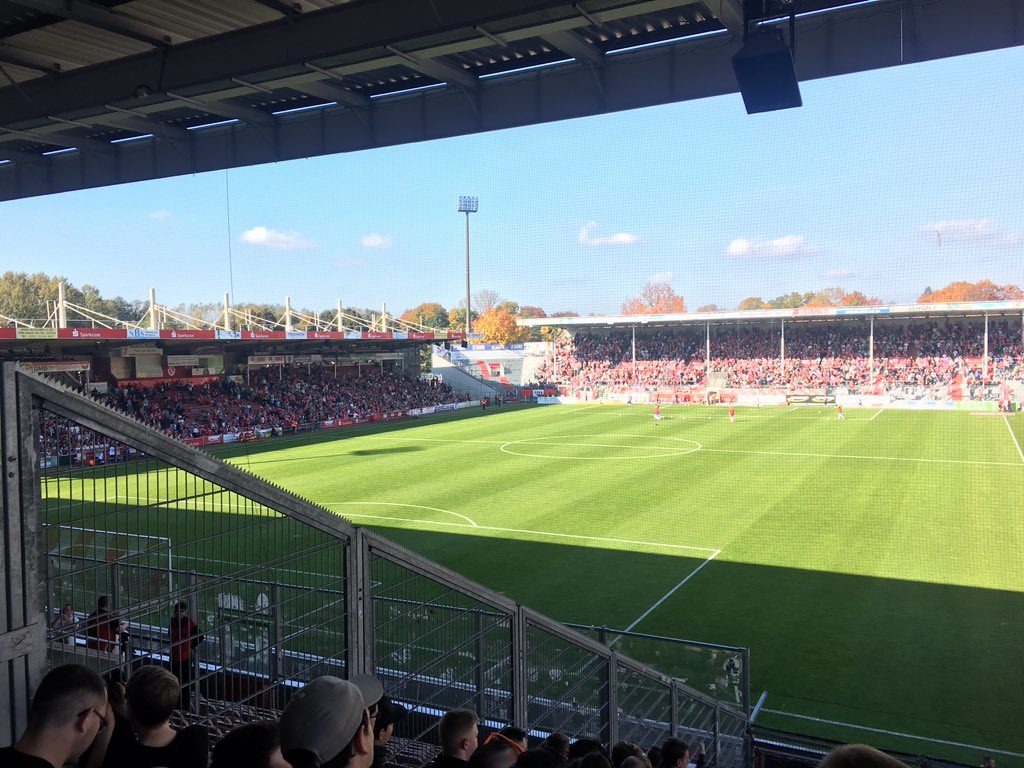Roadtrip dairy – Babelsberg trip to the lion's den in Cottbus


On October 15th, Energie Cottbus hosted Babelsberg in a highly anticipated and charged match. It was the first meeting between the two since last season’s trouble-filled affair on April 28th, the fall-out of which you can read about here.
The events of April 28th are ever-present and have helped bring some previously neglected issues into the broader public consciousness. The foremost being the presence and influence of a highly problematic right-wing element in the Cottbus organised fan scene. For those who have followed the club closely over the years, this is nothing new, or surprising. The first time the club made national headlines was during the Regionalliga promotion play off match against Hannover 96 in the 1996/97 season when some fans in the stands made monkey noises and threw banana skins at Otto Addo and Gerald Asamoah.
https://www.youtube.com/watch?v=dQUxQoLNtw0
Football-wise, Cottbus has been largely irrelevant since their relegation from the Bundesliga in 2009, playing the last two seasons in the Regionalliga (4th tier). Cottbus is by no means a major city, thus they receive little outside press attention. Additionally, most wouldn’t consider Cottbus a ‘big’ club in the same sense as say Hansa Rostock. These factors have all contributed to the problems at Cottbus flying under the radar for so long.
The casual fan of German football, might shrug and say, so what, most clubs in the former East Germany, and a surprising number in the West, have at least some, varying degree of problems with right-wing extremists in the stadium. While this is true, the problem at Cottbus is unique in its size and severity. As of last spring, police estimated the size of the problematic right-wing element at Cottbus at around 100 people. Rare in Germany, but not uncommon in places like Poland and the Balkans, the group is involved in organised criminal activity such as prostitution and drug dealing. The group has also not shied away from openly admitting, and advertising, their extreme-right political orientation. The group has used threats of violence and intimidation to suppress other active fan and ultra groups.
Observations from the match day
I was at the match on October the 15th. I got a ticket in the Babelsberg guest-block and went along with a group I knew through some mutual friends. Many of the Babelsberg away contingent, myself included, met the morning of the match at Alexanderplatz and took the train from there. Shortly after boarding, we were joined on the train by police in full riot gear(who would also accompany us on the train journey home). Cottbus is due Southeast of Berlin, not far from the Polish border and we were on the train for a little over an hour. When we arrived at the city we had a large police presence waiting for us. They had completely blocked off the road leading from the train station to the stadium, about a 1.5 kilometer stretch.
As a result of the extremely heightened security measures, I did not get to see much of the city itself. Although what little I did see reminded me of other similarly-sized cities in the former East Germany, as I have previously lived in Dessau, Sachsen-Anhalt, and have traveled extensively in the region. Cottbus is the butt of many jokes about the old GDR; gray, ugly, empty, soulless, etc. Maybe I am just desensitized to GDR-style architecture by now, or maybe it was the picturesque fall day, but the city did not seem to do its reputation justice.
The walk to the stadium was lined not only with police, but with Energie Cottbus stylized graffiti, some of which was your typical run of the mill fan artwork, but others contained more sinister messages and imagery. As the stadium came into view we crossed over a bridge, which, I was informed, was the site of fan trouble between the two fanbases in earlier years.

In order to enter the stadium, we had to go through intense security measures, which would rival most airports, including taking off our shoes. The match went down without any major incidents. The fan-blocks are at opposite ends of the ground at Cottbus, which is not the case at Babelsberg, where the two fan blocks are adjacent to each other. This, combined with heightened security and police presence, made sure that the match went down without any fan-trouble like in meetings past. This is merely conjecture on my part, but I have a feeling the Cottbus management may have confiscated and/or banned fan displays for the match, as Cottbus did not have any sort of tifo or messages, which is atypical for the derby, especially while hate between the two seems to be at an all-time high.
The final score may have also contributed to the relative calm. Cottbus controlled the match start to finish and won 4-0. They are running rampage on the competition and are odds-on favorites to win the league, having gained 34 points from 12 matches so far
Background: Why do Energie have problems with right wing fans?
The problems at Cottbus do not exist in a vacuum, rather they reflect unfortunate realities in region’s current socio-political climate. In Cottbus’ voting district, the radical-right AfD party garnered over 25% in September’s federal elections. Furthermore, 1,437 people cast votes for the NPD, an openly Nazi party, even further right on the political spectrum than the AfD. The state of Brandenburg has been dealing, largely unsuccessfully, with violent right-wing extremism for years now, not dissimilar to many of the new states that formerly comprised East Germany.
The club has recently, finally, decided to do something about the problem. The timing seems disingenuous, however. Only as the problem has spiraled out of control has the club finally said it’s time to act. Although there is no one actor solely responsible for the problems at Cottbus, some fault does lie with the club, as they neglected to heed the warning signs and are now paying the price. It is also worth mentioning that Cottbus has faced on-the-field problems as well in recent years, and it would be naive to say the two aren’t in some ways related.
Another actor at fault is the NOFV (Northeast Football Association). As Niklas explained in his previous piece, the association has failed to adequately condemn the actions of Cottbus’ supporters during last spring’s match. In fact, they even fined Babelsberg for their supporters’ role in the incident, in a move eerily akin to Donald Trump’s, “both sides” comments following Charlottesville. The NOFV could have used the opportunity to send a message to Cottbus(and other clubs). They could have handed them a major set of fines (rather than the meager 14,000 sum they decided upon) and mandated an extensive set of behind-closed-door matches (rather than the one they ordered), or they could have even gone a step further and deducted points. Though Cottbus is running the league, hitting a club like Cottbus where it hurts, in the coffers and/or the table, is bound to force the club to take more concrete action.
By allowing Cottbus to emerge from the events of April 28th relatively unscathed, the association is setting a dangerous precedent, as the NOFV Regionalliga has a politically and culturally polarized set of clubs this season. Lok Leipzig and BFC Dynamo have Cottbus-esque elements within their respective fan scenes. Chemie Leipzig, like Babelsberg, is a left-oriented club. Then there is a club like Berkiner AK, who has strong ties with the Turkish community in Berlin. Furthermore, there are clubs like Budissa Bautzen, where there may not be an ‘active’ fan scene per say, but the political climate in such places is very right-wing oriented. Cities like Halberstadt and Auerbach would also fall into this camp. Thus making the number of potential high-risk matches in the league this season is extremely high.
The two clubs will meet again in the Rückrunde at Babelsberg’s Karl-Liebknecht Stadion. Due to the design of Babelsberg’s ground, that match will have a higher probability of trouble than did Sunday. As previously mentioned, at the Karl-Liebknecht Stadion the visiting fans are adjacent to the Babelsberg fan-block. The ground also does not have the same safety accommodations as Cottbus’ Stadion Der Freundschaft. Additionally, the clubs could meet a third time this season, as both are still alive in the Brandenburg Cup.
Babelsberg has started a campaign, “Nazis raus aus den Stadion” in order to promote the values their club stands for. They are selling t-shirts with the slogan, of which the profits will go toward financing the fine from the NOFV. Other clubs and supporters’ groups have also taken up the mission: recently Red Bull Leipzig fans showed a message in solidarity, and Fortuna Düssledorf will wear kits which read “Gegen Rechts” where the sponsor normally is.
It is also worth mentioning that there is a segment of the Cottbus fan community also trying to combat the problem. There is a Facebook page titled, “FC Energie Cottbus - Fans gegen Nazis.” The page has nearly 900 likes.
Initiatives from Cottbus fans and other clubs and fan sets are helpful and important, but they themselves will not bring about change. The biggest responsibility falls on the club itself. As previously mentioned, some blame also lies with the NOFV and the way the handled the events of April 28th. Everyone involved has a part to play - it would be wonderful to see players and coaches take a stand (or knee…?), for example. Ultimately, Cottbus has a long fight ahead, and it is possible that the problems are so deeply embedded that there is little chance of overcoming them. Though the situation at Cottbus could serve as a learning example, for other clubs who have small but emerging problematic elements popping up on their terraces; address the problem early and robustly.


 Apple podcasts
Apple podcasts Google podcasts
Google podcasts Spotify
Spotify TuneIn
TuneIn RSS feed
RSS feed Instagram
Instagram Blue Sky
Blue Sky